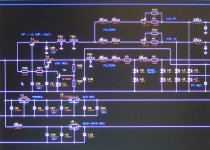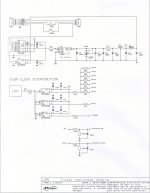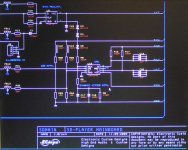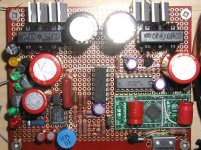What coupling caps give the most details?
A non-existing
But if you want to use a cap Mundorf Silber is nice.
What decoupling cap for TDA1543 is the best?
A non-existing
Hi Tolu
Having played a bit with the DAC now and trying a few things, I still find there are a lot of issues I have yet to explore. If your thinking of optimising the DAC I suggest you try a few things first before worrying too much about cap brands etc.
If you haven't as yet get the DAC running of battery power, if you can, even better still, split the power supply so that the 1543 chip has its own supply, this makes a significant difference.
Make sure the DAC is fed by the best possible signal in the first place, you won't hear the benefits of the mods unless this is taken care of first.
Check the coax cable, I found this had a significant impact, I made a nice one 1.5 meters in length, it sounded better than what I had by a reasonable margin.
I suspect there may be something to gain from changing the resistors between the outputs and the 3v battery. Two options here are to try smd resistors and try other values, the 680 ohm values may not be perfect for my system so I will try resistors either side of the 680ohm, I suspect I may end up with something closer to 640ohm, I am mainly looking at the level of high end grain/distortion, output is not an issue I already have more than enough.
I feel adding a much higher level of capacitance for the DAC chip is worthwhile I went with 1000 uf and I note EC is using 3600 uf, in my case it is an smd cap with chip cap right on the dac chip, these changes helped, the actual brand of cap is probably not that much of an issue I suspect.
Other items I will be experimenting with will include shielding the chips for better RF resistance and transmission, more capacitance for the DIR 9001 chip with separate lines for each side of the chip, choke on the DAC chip power supply, running with and without output caps, (I can do this as my system is holistic and designed to works as a complete unit).
Where possible I will hook up a small two way switch so I can A/B the circuits with and without the changed component and only move to the next item when I am sure of the effect of each change.
Overall I can confirm one thing, the DAC and its final sound is quite tuneable with small changes here and there so experimenting is worthwhile, the good thing is that is is cheap to do so.
As for the voltage, well I am on 5V and there is no issue at all with dynamics etc, but I imagine this is system dependent, anything over 8V is a no go, the chips max rating is 8V.
I did try different batteries types, SLA, big 12V car battery and AA NiMh, they all sounded identical, so probably nothing to gain there, the only thing that seemed to matter was the capacitance values.
Of course all of this is moot if your running mains power, you are likely to only notice the most significant changes then and the mains noise/hash will obliterate most of the low level detail gains etc.
As a little aside I found feeding the DAC via the trends UD10 with 16/44.1 sounded better than higher bit/sample rate files. The higher bit depth files sounded a bit louder but seemed nowhere as smooth. In fact I noticed ringing with the higher bit depth files played back via the 16/44 settings though itunes
I have decided to try one music track at different sample rates and depths and run it from iTunes into the system for comparision, changing the midi settings as needed. I suspect that there are gains to be made by finding the perfect original recording settings, which I think will probably end up being 16/44.
Have fun.
Having played a bit with the DAC now and trying a few things, I still find there are a lot of issues I have yet to explore. If your thinking of optimising the DAC I suggest you try a few things first before worrying too much about cap brands etc.
If you haven't as yet get the DAC running of battery power, if you can, even better still, split the power supply so that the 1543 chip has its own supply, this makes a significant difference.
Make sure the DAC is fed by the best possible signal in the first place, you won't hear the benefits of the mods unless this is taken care of first.
Check the coax cable, I found this had a significant impact, I made a nice one 1.5 meters in length, it sounded better than what I had by a reasonable margin.
I suspect there may be something to gain from changing the resistors between the outputs and the 3v battery. Two options here are to try smd resistors and try other values, the 680 ohm values may not be perfect for my system so I will try resistors either side of the 680ohm, I suspect I may end up with something closer to 640ohm, I am mainly looking at the level of high end grain/distortion, output is not an issue I already have more than enough.
I feel adding a much higher level of capacitance for the DAC chip is worthwhile I went with 1000 uf and I note EC is using 3600 uf, in my case it is an smd cap with chip cap right on the dac chip, these changes helped, the actual brand of cap is probably not that much of an issue I suspect.
Other items I will be experimenting with will include shielding the chips for better RF resistance and transmission, more capacitance for the DIR 9001 chip with separate lines for each side of the chip, choke on the DAC chip power supply, running with and without output caps, (I can do this as my system is holistic and designed to works as a complete unit).
Where possible I will hook up a small two way switch so I can A/B the circuits with and without the changed component and only move to the next item when I am sure of the effect of each change.
Overall I can confirm one thing, the DAC and its final sound is quite tuneable with small changes here and there so experimenting is worthwhile, the good thing is that is is cheap to do so.
As for the voltage, well I am on 5V and there is no issue at all with dynamics etc, but I imagine this is system dependent, anything over 8V is a no go, the chips max rating is 8V.
I did try different batteries types, SLA, big 12V car battery and AA NiMh, they all sounded identical, so probably nothing to gain there, the only thing that seemed to matter was the capacitance values.
Of course all of this is moot if your running mains power, you are likely to only notice the most significant changes then and the mains noise/hash will obliterate most of the low level detail gains etc.
As a little aside I found feeding the DAC via the trends UD10 with 16/44.1 sounded better than higher bit/sample rate files. The higher bit depth files sounded a bit louder but seemed nowhere as smooth. In fact I noticed ringing with the higher bit depth files played back via the 16/44 settings though itunes
I have decided to try one music track at different sample rates and depths and run it from iTunes into the system for comparision, changing the midi settings as needed. I suspect that there are gains to be made by finding the perfect original recording settings, which I think will probably end up being 16/44.
Have fun.
Gday Tolu
Stacking will increase the output level but according to most who have tried it there is no improvement in sound quality, in fact many including EC seem to feel it is actually worse.
In theory this seems odd as it should increase dynamic range and lower distortion but the reality seems to be different.
I imagine though that stacking may be better than parallel operation where you then have to contend with variations between the circuit traces, supplies and components feeding each chip. One problem with stacking is the chip underneath can run quite a bit hotter than the one/ones on top, this might cause some problems long term or even short term if the supply voltage is high.
Overall you should be able to hear a better sound via batteries, in my system it is very obvious, however I must point out that my entire system is "off the grid"on batteries so any gear I add that is mains supplied clearly telegraphs is power source through the system.
Its fair to say that if the rest of a system is not totally clean then the gains from battery power may not be obvious. Mind you the power in my area may be particularly bad also, though I doubt it as I live in an estate on the outskirts of a middle sized town with little industry etc and few close neighbours.
In the end though if your getting good results on the mains then there's nothing to worry about.
Cheers
Stacking will increase the output level but according to most who have tried it there is no improvement in sound quality, in fact many including EC seem to feel it is actually worse.
In theory this seems odd as it should increase dynamic range and lower distortion but the reality seems to be different.
I imagine though that stacking may be better than parallel operation where you then have to contend with variations between the circuit traces, supplies and components feeding each chip. One problem with stacking is the chip underneath can run quite a bit hotter than the one/ones on top, this might cause some problems long term or even short term if the supply voltage is high.
Overall you should be able to hear a better sound via batteries, in my system it is very obvious, however I must point out that my entire system is "off the grid"on batteries so any gear I add that is mains supplied clearly telegraphs is power source through the system.
Its fair to say that if the rest of a system is not totally clean then the gains from battery power may not be obvious. Mind you the power in my area may be particularly bad also, though I doubt it as I live in an estate on the outskirts of a middle sized town with little industry etc and few close neighbours.
In the end though if your getting good results on the mains then there's nothing to worry about.
Cheers
Along Taralga Road?
I think I will try ECs solution but my problem is the Lightspeed pre with zero gain. So, stacking of 4 would give me 1.7 Vrms which seems to be enough to drive my Atoll power amp.
When I get some TDAs I will try both. Also I am very interested in ECs sd-card player.
I think I will try ECs solution but my problem is the Lightspeed pre with zero gain. So, stacking of 4 would give me 1.7 Vrms which seems to be enough to drive my Atoll power amp.
When I get some TDAs I will try both. Also I am very interested in ECs sd-card player.
Along Taralga Road?
I think I will try ECs solution but my problem is the Lightspeed pre with zero gain. So, stacking of 4 would give me 1.7 Vrms which seems to be enough to drive my Atoll power amp.
When I get some TDAs I will try both. Also I am very interested in ECs sd-card player.
I think I will try ECs solution but my problem is the Lightspeed pre with zero gain. So, stacking of 4 would give me 1.7 Vrms which seems to be enough to drive my Atoll power amp.
When I get some TDAs I will try both. Also I am very interested in ECs sd-card player.
Hi Tolu
Along Crookwell Road, not that far from Taralga road though.
I can see how the lack of gain would be an issue, so stacking might be a suitable solution, does the Atoll really need that much input to drive it to clipping, I am not familiar with the amp but that seems a high figure.
I can confirm that any active pre between the DAC and the power amp degrades the quality of the final result in my situation, but of course that's not practical if the input impedance etc don't work for the application.
If you do need a boost a possibility is to build a very simplified pre amp that just consists of a single gain stage and buffer with the gain variable by changing the feedback resistor as needed using a 5 position switch for example loaded five different resistors per channel, this can be made very small and run of battery power +/- and optimised for the application. In truth 5 different volume levels should be enough for most needs. You could eliminate uneccessary capacitors etc and the drive the power amp direct from that. In the end this might actually sound better than multiple chips and can be made very cheaply if you just want to try it out. The op amp chosen may have an effect on the sound, I have found with this DAC the Burr Brown 2134 series seems to match nicely probably as it is a bit mellow in its presentation so it smoothes the sound a bit, other more revealing and often expensive op amps may not work so well and could well sound harsh, and I know the cheap jellybean ones like the LM833 sound pretty horrible in this application.
In my experience a lot of the problems with op amp pre amp stages is not op amps themselves but the actual application, by this I mean, less than stellar power supplies, poor circuit layouts, bad bypassing, poor shielding etc, attention to details can make big differences here so such circuits don't have to sound bad.
I actually built something like this to boost a phono stage with all the circuits built point to point right on the switch, it actually sounds very nice ( and much better than subsequently feeding the signal through a following pre amp and all its attendant circuits, switches, caps and volume pots) and has worked flawlessly for a couple of years now.
Cheers
Zero One
Along Crookwell Road, not that far from Taralga road though.
I can see how the lack of gain would be an issue, so stacking might be a suitable solution, does the Atoll really need that much input to drive it to clipping, I am not familiar with the amp but that seems a high figure.
I can confirm that any active pre between the DAC and the power amp degrades the quality of the final result in my situation, but of course that's not practical if the input impedance etc don't work for the application.
If you do need a boost a possibility is to build a very simplified pre amp that just consists of a single gain stage and buffer with the gain variable by changing the feedback resistor as needed using a 5 position switch for example loaded five different resistors per channel, this can be made very small and run of battery power +/- and optimised for the application. In truth 5 different volume levels should be enough for most needs. You could eliminate uneccessary capacitors etc and the drive the power amp direct from that. In the end this might actually sound better than multiple chips and can be made very cheaply if you just want to try it out. The op amp chosen may have an effect on the sound, I have found with this DAC the Burr Brown 2134 series seems to match nicely probably as it is a bit mellow in its presentation so it smoothes the sound a bit, other more revealing and often expensive op amps may not work so well and could well sound harsh, and I know the cheap jellybean ones like the LM833 sound pretty horrible in this application.
In my experience a lot of the problems with op amp pre amp stages is not op amps themselves but the actual application, by this I mean, less than stellar power supplies, poor circuit layouts, bad bypassing, poor shielding etc, attention to details can make big differences here so such circuits don't have to sound bad.
I actually built something like this to boost a phono stage with all the circuits built point to point right on the switch, it actually sounds very nice ( and much better than subsequently feeding the signal through a following pre amp and all its attendant circuits, switches, caps and volume pots) and has worked flawlessly for a couple of years now.
Cheers
Zero One
Battery bias for NOS 1543
Have you tried LED biased instead of battery per EC's new design?
Mine was NiMH biased (3.8-4V with 910 I/V), it sounded cogested in middle and low range compared to the new one.
DJA and Async reclock do make a big difference as well. (sound stage opened up)
I am using seperate Reg for LED (John Swenson/ECdesign) and 1543 (AN8005).
Regards
Have you tried LED biased instead of battery per EC's new design?
Mine was NiMH biased (3.8-4V with 910 I/V), it sounded cogested in middle and low range compared to the new one.
DJA and Async reclock do make a big difference as well. (sound stage opened up)
I am using seperate Reg for LED (John Swenson/ECdesign) and 1543 (AN8005).
Regards
I tried this mod and posted some impressions on the AOS forum
I'd like to say a big thank you to ecdesigns for sharing this, IMHO with this mod the TDA1543 is the best I've heard it!!!
Before the mod I was using 2k7 Riken I/V, 1k5 Riken Ref , 8v supplying the TDA1543 using AN8008
I built the TDA1543 + ecdesigns mod on a separate piece of vero and tapped into the I2S lines
Last edited:
LED biased instead of battery per EC's new design?
Hey 2A3SET,
Pls visualize as it isn´t absolutely clear how you mean. Sounds interesting though.
Here is EC's power reg design with LED bias
Here is EC's power reg diagram with LED bias posted in the ultimate 1541 thread. Two green LED set the voltage to 4V, then another two Red lower it to 3.2V.
The others are async reclock part and dynamic jitter attenutator.
Here is EC's power reg diagram with LED bias posted in the ultimate 1541 thread. Two green LED set the voltage to 4V, then another two Red lower it to 3.2V.
The others are async reclock part and dynamic jitter attenutator.
Hey 2A3SET,
Pls visualize as it isn´t absolutely clear how you mean. Sounds interesting though.
Attachments
Last edited:
- Status
- This old topic is closed. If you want to reopen this topic, contact a moderator using the "Report Post" button.
- Home
- Source & Line
- Digital Line Level
- Diy-dac 1543



